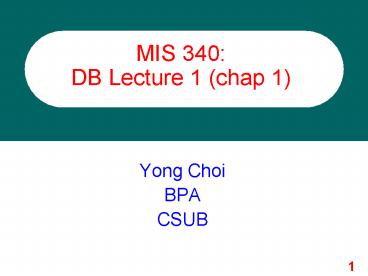MIS 340: DB Lecture 1 (chap 1) - PowerPoint PPT Presentation
Title:
MIS 340: DB Lecture 1 (chap 1)
Description:
... Builders International Mainframe/PC IMS IBM Mainframe Ramis Online Software International Mainframe Network ADABAS Software AG of North America Mainframe ... – PowerPoint PPT presentation
Number of Views:64
Avg rating:3.0/5.0
Title: MIS 340: DB Lecture 1 (chap 1)
1
MIS 340 DB Lecture 1 (chap 1)
- Yong Choi
- BPA
- CSUB
2
Basic DB Terms
- Data Meaningful facts, text, graphics, images,
sound, video segments - A collection of individual responses from a
marketing research - Information Data processed to be useful in
decision making - Pattern of geographical buying habit based on
analysis of a marketing research - Metadata Data that describes data
3
Data in Context
Large volume of facts, difficult to interpret /
make decisions
4
Information
Useful for decision making / interpretation
5
Metadata
Descriptions of the properties or characteristics
of the data, including data types, field sizes,
allowable values, and documentation (Data
Dictionary)
6
Database Systems
7
Database Systems
- Collection of electronic data
- Central repository of shared data
- Stored in a standardized, convenient form.
- Requires a Database Management System (DBMS)
8
Advantages of Central Database
- Reduce data redundancy
- Same customer address for each Dept.
- Reduce data inconsistency
- New real time updates for every Dept.
- Eliminate application-data dependency
- Improve data sharing
- Enforce standardization
9
Evolution of DB Models
- File processing system (traditional)
- Hierarchical
- Network
- Relational
- Object-oriented
- Object-relational
10
Hierarchical Database
11
Network Database
12
Relational Database
- A relational database is a collection of tables
that are related to one another based on a common
field. - A common field is called a primary key(s).
- unique identifier in data model (ERD)
- When the primary key of one table is represented
in a second table to form a relationship, it is
called a foreign key.
13
Relational Database
14
Relating Tables Using a Common Field
The primary key in the Employer table
(EmployerID) is the common field that relates
this table to the Position table.
PositionID is the primary key in the Position
table. The EmployerID field is a foreign key in
this table.
Primary keys can only have one occurrence in a
table. Foreign keys may have multiple occurrences.
15
Relational Database
- Advantages
- Easier database design, implementation,
management, and use - Ad hoc query capability with SQL
- Powerful database management system
16
(No Transcript)
17
Database Applications
- Personal Database standalone desktop database
- Workgroup Database local area network (lt25
users) - Department Database local area network (25-100
users) - Enterprise Database wide-area network (hundreds
or thousands of users)
18
An Enterprise Data Warehouse
Collection of historic NOT current data
19
Data Mining
- Help to find hidden patterns and relationships in
large databases to predict future behavior - If a house is purchased, then new refrigerator
will be purchased within two weeks 65 of the
time.
20
Components of the DB Environment
- CASE Tools computer-aided software engineering
- Repository (data dictionary) centralized
storehouse of metadata - Database Management System (DBMS) software for
managing the database - Database storehouse of the data
- Application Programs software using the data
- User Interface text and graphical displays to
users - Database Administrators (DBA) personnel
responsible for maintaining the database - System Developers personnel responsible for
designing databases and software - End Users people who use the applications and
databases
21
Components of the DB Environment
22
Database Development Process
Feasibility Study of Project
Purpose preliminary understanding Deliverable
request for project
Requirement Analysis
Conceptual Design
Logical Design
- Is the project worth looking at ? - Is the DB
system worth building?
Physical Design
Implementation
Maintenance
23
Database Development Process
Purpose state business situation and possible
solution Deliverable decomposed requirements
Feasibility Study of Project
Requirement Analysis
Conceptual Design
Logical Design
- What do users need and want from the new
system? - What the new system must do
Physical Design
Implementation
Maintenance
24
Database Development Process
Purpose thorough analysis Deliverable
conceptual data model
Feasibility Study of Project
Requirement Analysis
Conceptual Design
Logical Design
- conceptual data model
- next slide
- example model from the web page
Physical Design
Implementation
Maintenance
25
Conceptual Data Model
26
Database Development Process
Feasibility Study of Project
Purpose information requirements
structure Deliverable logical database design
Requirement Analysis
Conceptual Design
- Hierarchical DB
- Network DB
- Relational DB
- Object Oriented
Logical Design
Physical Design
Implementation
Maintenance
27
Database Development Process
Purpose develop technology specs Deliverable
program/data structures, DB technology purchases
Feasibility Study of Project
Requirement Analysis
Conceptual Design
Logical Design
Physical Design
- Define physical organization of data
Implementation
Maintenance
28
Database Development Process
Purpose testing, training, debugging,
installation, documenting Deliverable
operational programs, documentation, training
materials
Feasibility Study of Project
Requirement Analysis
Conceptual Design
Logical Design
Physical Design
Implementation
Maintenance
29
Database Development Process
Feasibility Study of Project
Purpose monitor, repair, enhance Deliverable
periodic audits
Requirement Analysis
Conceptual Design
Logical Design
Physical Design
Implementation
Maintenance
30
DB Development Schedule
Gantt Chart shows time estimates of tasks
31
DB Development Schedule
PERT Chart shows dependencies between tasks
32
Incremental Commitment in DB Development
- Project is reviewed at the end of each
development phase - Re-justify the process under the light of new
requirements and available resources - Renew commitment of stakeholders
- Continue / Revise Scope / Cancel































